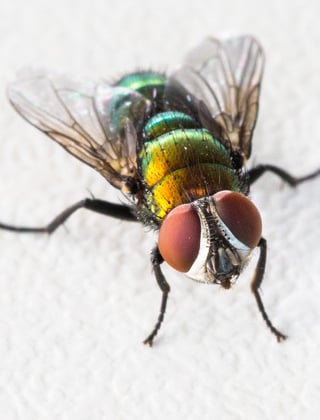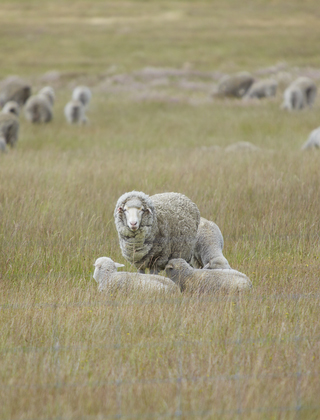Current Flystrike Research

An overview of the AWI flystrike program and its progress.
AWI’s Flystrike Research, Development, Education, Extension and Communication (RDEEC) program represents a diversified RD&E investment in the principles of integrated pest management in the search for practical solutions for woolgrowers to prevent flystrike, ensuring the lifetime welfare of individual sheep, whilst reducing reliance on mulesing.

Management Practices
AWI’s research investment to date into management practices to reduce the risk of flystrike, such as frequency and timing of shearing and crutching, timing of lambing, appropriate nutrition and pasture management and better worm and dag control, ensures woolgrowers have access to best practice information.
Parasiticides for the prevention and treatment of all forms of flystrike and worms are important tools in managing flystrike risk and when used strategically and in conjunction with other management tools, further reduce the risk of flystrike in sheep. Better management of current chemicals, the improved delivery of these chemicals and the development of new chemicals will minimise the risk of worms and dags and blowflies and their larvae developing chemical resistance, ensuring that growers retain access to effective chemical treatments in to the future to improve the lifetime welfare of all sheep.
Some of current or recently completed R&D projects in this area include nanotechnology, fly genome sequencing and an investigation into the development of a flystrike vaccine.
AWI's latest publications on flystrike management, including project reports, are available at www.wool.com/flystrikelatest/#management
For information specific to managing chemical resistance see www.wool.com/demystifly.
Breeding and Selection
Breeding sheep naturally resistant to all forms of flystrike is a long-term solution to managing the risk of flystrike in some types of Australian wool sheep. Breeding strategies must also integrate objectives for other health and welfare traits such as worm resistance, conformation and reproductive performance. For woolgrowers who are working to reduce their reliance on mulesing, the goal is to maintain or improve productivity outcomes, whilst breeding a flock that has enhanced resistance to breech flystrike and that can be managed effectively, without the need for mulesing or for a high reliance on chemical control.
There is no one-size-fits-all sheep breeding program and breeding strategies need to be customised to the individual farm to suit sheep breed, wool type and environment, guided by key principles identified from AWI’s investment to date in breeding for breech flystrike resistance.
AWI invests strongly in identifying and promoting optimal breeding options and strategies for woolgrowers to employ to meet their breeding objective. Examples include Wether Trials, Ewe Trials, Australian Merino Sire Evaluation and MERINOSELECT.
AWI's latest publications on breeding and selection for flystrike resistance, including project reports, are available at www.wool.com/flystrikelatest/#breeding
Breech Modification Procedures
AWI’s investment in management practices to reduce the risk of flystrike includes support for welfare improved breech modification procedures. Whilst flystrike management and breeding practices are critical and investment is ongoing, they cannot offer sufficient protection from flystrike for a large, vulnerable portion of the Australian flock in the short to medium term.
The one-off mulesing procedure provides lifelong protection, ensuring treated sheep do not suffer a slow and painful death from flystrike. However, it is acknowledged that there are welfare impacts of the mulesing procedure itself and AWI invests heavily in minimising these impacts.
A critical advance in this regard is the development of effective analgesia and anaesthesia – detailed further below. Additional activities in this area include research optimising mulesing for minimal welfare impact and information on performing the procedure: it includes the selection of lambs needing mulesing, the size of the procedure and optimal management during and following the procedure. What was the National Mulesing Accreditation Program (NMAP) manual has been updated by AWI with WoolProducers Australia and the Livestock Contractors Association and was published as the “Plan, Prepare and Conduct Best Welfare Practice Lamb Marking Procedures – Training Guide”.
AWI has also invested in R&D into alternative breech modification procedures to improve the lifetime resistance of sheep to flystrike. This has included investigations into the development of Anti-Flystrike Clips, Skintraction and Liquid Nitrogen Process. Independent to AWI, AgVet Innovations has continued to further invest in the development and assessment of their Sheep Freeze Branding, that uses liquid nitrogen.
AWI is currently funding a preliminary laser treatment study using new dual wavelength technology to determine safe laser power levels that are effective for wool removal but will not damage the sheep’s skin. The advantage it has could be through providing a permanent crutch.
Analgesia and Anaesthesia
The development of effective and practical anaesthetic and analgesic treatments for lambs has been a critical advance in alleviating the pain and distress lambs experience associated with husbandry procedures such as mulesing, castration and tail docking
The provision of anaesthesia and analgesia during husbandry procedures has been shown to significantly reduce stress and pain for lambs, with follow-on benefits reported by growers of faster ‘mothering up’, faster healing and better recovery.
AWI invests in this area to assist with product development and making sure effective alternative anaesthesia and analgesia options are available for woolgrowers to use, as well as education and extension to enhance their uptake and use.
AWI's latest publications on analgesics and anaesthetics, including project reports, are available at www.wool.com/flystrikelatest/#research-analgesia
Education, Extension and Promotion
There are many challenges involved in identifying solutions that meet the diverse range of sheep and wool type, environment and farm business priorities under which Australian woolgrowers operate. Accordingly, they have adopted a complex integrated pest management approach to reducing the risk of flystrike to ensure the best lifetime welfare of their sheep.
AWI is responsible for ensuring woolgrowers and their advisors have access to best practice information and support to meet the wide range of management options for improved lifetime welfare of sheep, and that domestic and international stakeholders are aware of, and understand, best practice management of flystrike and the welfare implications.
AWI’s Flystrike Extension Program supports woolgrowers in improving the lifetime welfare of their sheep, reducing their reliance on mulesing and crutching, optimising chemical use and increasing whole farm profitability through the provision of practical information and tools and access to accredited advisor support. Find out more about it at www.wool.com/flystrikeresources.
AWI also regularly engages with domestic and international stakeholders to ensure they understand best practice management of flystrike and the welfare implications. This includes:
- Regular AWI Animal Welfare Forum, which is an opportunity for key animal welfare groups to meet researchers involved in the flystrike RDEEC program and discuss project outcomes. Animal welfare groups that attend the forum include RSPCA Australia, RSPCA Victoria, RSPCA NSW, Animals Australia, Four Paws in Australia and The Humane Society International - Australia.
- Biennial AWI Flystrike RD&E Forum.
- Regular engagement with international and domestic brands and retailers by the Woolmark Regional Managers, both within Australia and internationally.
Measuring, monitoring and improving the success of education, training and extension programs in delivering on-farm husbandry practice change for flystrike, enabling industry to better demonstrate its commitment to ensuring lifetime welfare of sheep. Results from woolgrower surveys of their practices are available at www.wool.com/flystrikelatest/#woolgrower-surveys














